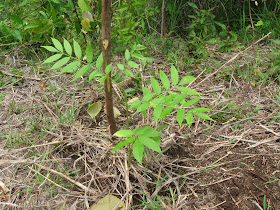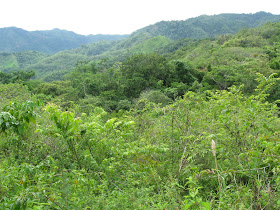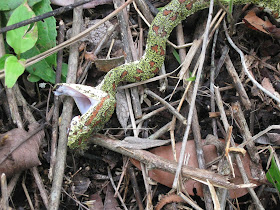
(first tree planted, a Cedro Amargo)
The farmer and I have a reforestation project on the Pacific side of Costa Rica. This last week we were there to start planting the trees we've been collecting since March. The Pacific side has a wet and dry season and the wet just started, we had to wait for the rains to come before putting anything in the ground.
It's an interesting project, a 100 hectare parcel(about 220 acres) of abandoned cattle pasture, 80% of which is to be reforested. The land itself is very beautiful being foothills of a coastal mountain range, but very close, about 5 kilometers from the ocean. The highest point is over 320 meters (over 1000 feet), and the lowest about 14 meters above sea level. It's a fairly steep climb to the top and the dirt road and tractor tracks are well eroded and slippy for even the horses. A road of sorts has been put in from the main road past the property, but with our two wheel drive pick-up it was challenging, if not downright scary, to drive.
The owners have had the piece for about 9 years, and although there have been cattle grazing it really is abandoned pasture. Cows eat grass, no surprise there, but really grass is about all they'll eat. Sometimes they'll nibble on a little vegetation, but grass is their thing. So over time seedlings and saplings from other trees and plants will grow in the pasture, the seeds probably dropped by birds or carried on hoofs or coats, or even the wind. The cows will munch around and about but unless someone is there to take care of the pasture and chop these saplings, they will grow. With all the sun and manure and with the cows conveniently keeping the grass low, the seedlings and saplings grow well and begin to overshadow the grass. The grass dies back, and other plants come in to take their place: a forest begins.
These pioneer species, in this case guava, wild orange, cenizaro, ronron, espavel and a few others, bring in their own community of non grass plants and soon small islands of woodland spring up in the pasture. Small trees form canopy and underbrush appears which in turn provides shade and mulch for ground covers, more delicate species and fungi. The whole now provides habitat for insects, toads, reptiles, birds and mammals and as it grows it is nourished by the manure and decaying remains of insect and animal life. With more animal species there is more chance of seeds being dispersed, and so the little wood grows. Pioneer species gradually make way to settler species which at some point will overshadow those first small trees, and over time the pasture will disappear under the growing forest. It's all very natural and very beautiful. Unless you're a rancher.

Our job is to help the spread of this natural forest by planting native forest trees. Though we are also orchestrating the land and thus the forest by deliberately planting specific areas with fruit trees and trees favored by certain animal and bird species, notably the Macaw parrot. In most parts of Costa Rica reforestation means plantation and it is hard to find examples of new natural forest; plantations being more or less monocrops, managed and harvested after several years. It has taken us much time and effort to find appropriate trees, most nurseries don't stock native forest trees. But we have managed to piece together over 3,000 saplings.
We had expected to have the land prepared for planting, but arrived to find it untouched. This meant we had to clear as we went. We cut paths through the scrub and cleared meter and a half circles around each planting site, planted the tree then mulched the site with leaf matter and twigs. We staked it too - it's the wet season and things grow fast. The land will need maintenance and we certainly don't want an irresponsible swing of the machete to cut the sapling off before it can even begin. With each plant well staked the maintenance crew will know where to look and where to cut.
It was hard work lugging the saplings up and down the hills, slipping in the mud, getting torn by thorns and brush. Our crew of Nicaraguan and Costa Rican workers worked hard and whistled as they went, and we were alternately dripping with rain and sweat as we chopped, dug, planted and mulched throughout the week. We did kill a snake, a pit viper, that struck at a worker from a tree branch he was cutting. I was sorry to see it dead, such a beautiful looking creature, but happy it hadn't bitten him.

This is an unusual project in that we are working to recreate a natural forest and because of this it is being highly documented: every tree we planted has a GPS tag, and every tree over 8 inches in diameter already on the land is also tagged. We should be able to watch and monitor the growth of the forest, an exciting prospect.
No comments:
Post a Comment
thanks for sharing!